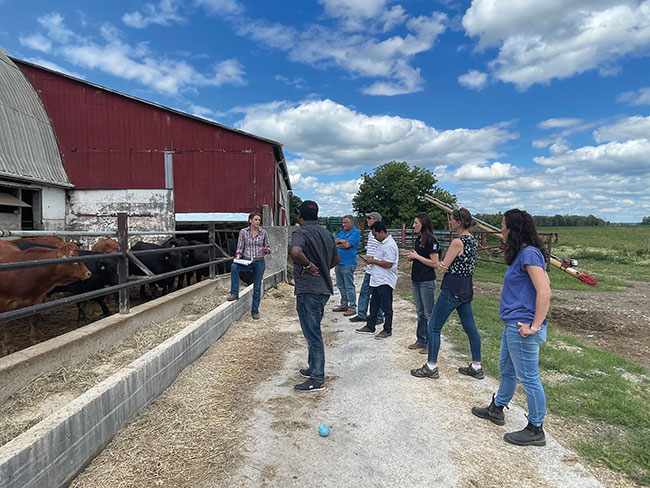
LRIC Update: The future of livestock innovation
By Livestock Research Innovation Corporation (LRIC)
FeaturesReport provides recommendations for improving livestock innovation.
 Early career researchers from University of Guelph on a farm tour as part of LRIC efforts to strengthen relationships between farmers and researchers. PHOTO CREDIT: LRIC
Early career researchers from University of Guelph on a farm tour as part of LRIC efforts to strengthen relationships between farmers and researchers. PHOTO CREDIT: LRIC Innovation is widely touted as the source of solutions to many of the big issues facing animal agriculture, from climate change and environmental footprint to antimicrobial resistance and animal health and welfare.
According to Livestock Research Innovation Corporation (LRIC) CEO Mike McMorris, Ontario has a very good livestock innovation system, but as with anything, there are always ways to do things better – and it’s important to stay on top (or better yet, ahead) of changing trends and issues.
“Our organization has a mandate of continuous improvement, achieved best by working with all parties in the system, which includes industry organizations, University of Guelph and the Ontario Ministry of Agriculture, Food and Rural Affairs,” he explains.
It’s that mandate that led to a recent review of the innovation system by LRIC’s International Research Advisory Committee, a process that included a review of written briefs, and surveys of University of Guelph faculty and industry organizations. McMorris is pleased with the response rate of 53 faculty and 11 industry organizations, noting it demonstrates keen interest in charting a new course forward.
“The report is concise by design and brings clear focus to the need for more collaboration between industry, government and academia,” he says. “This is something we’ve been hearing about anecdotally for some time, and this report confirms the need to make this a stronger priority for the livestock industry.”
The resulting report includes 10 recommendations developed by the committee that reflect the feedback received and can help result in meaningful change:
- Closer working relationships between research and industry, along with well-defined problem statements from the industry
- Adequate funding for Ontario’s new research and innovation facilities to ensure optimal return on the investment
- Establishment of research priorities using a collaborative approach that involves industry, government, and faculty
- Willingness by the livestock sector to look sideways and learn about the issues and opportunities in other sectors
- Competitively priced overhead charges at research facilities
- More focus on the entire innovation system instead of one of siloed activities
- Collaboration by industry, government and faculty to create a new system of Getting Research Into Practice (GRIP) with an industry champion for each project.
- Include excellence in GRIP and building strong relationships with industry as part of the faculty reward system
- Engage social sciences to help improve adoption of research results
- A Canada-first focus in commercialization.
According to McMorris, LRIC will be focusing on two specific areas over the next year: developing a new process of setting research priorities and a new model for getting research into practice.
LRIC is recommending annual “Shark Tank” sessions to give researchers early industry input into research ideas and priorities. As well, cross-disciplinary research proposals – projects that include faculty from more than one department or school – should be encouraged and incentivized, and the timing of OMAFRA’s release of its research priority document should be consistent to give more time for industry input and proposal submission.
Industry, faculty, LRIC and OMAFRA must all work together to develop a new GRIP system. This should include enhanced communications, coordination of an annual livestock conference to bring together sector representatives for learning and discussion, and GRIP training and tools for researchers. As well, participation in GRIP should be included in faculty reward programs to encourage more widespread uptake and adoption.
“These recommendations also underscore the need for new poultry research facilities in Ontario, which, as we’re seeing in dairy and beef, will serve as the springboard for driving innovation in the sector,” adds McMorris.
The full IRAC report is available on the LRIC website at www.livestockresearch.ca.
Livestock Research Innovation Corporation (LRIC) fosters research collaboration and drives innovation in the livestock and poultry industry. Visit www.livestockresearch.ca or follow @LivestockInnov on Twitter.
Print this page